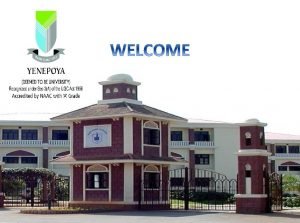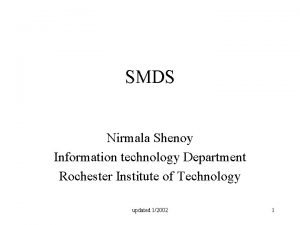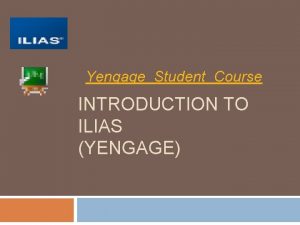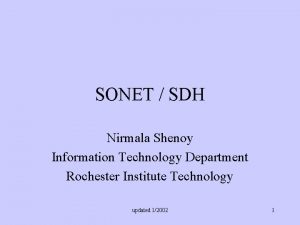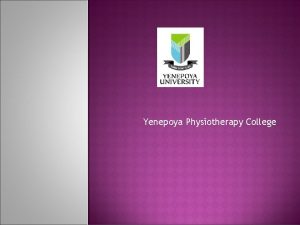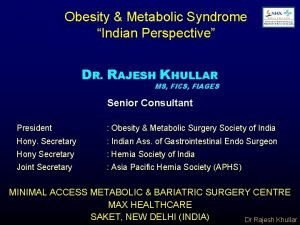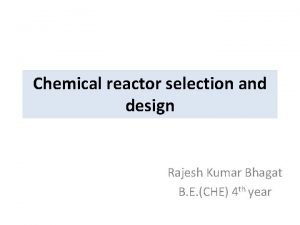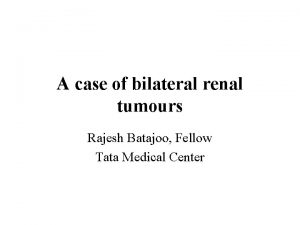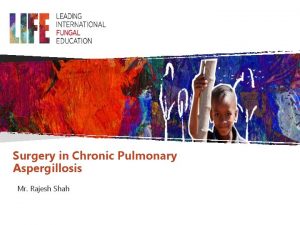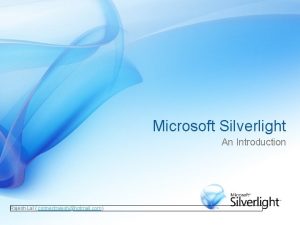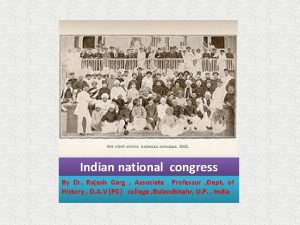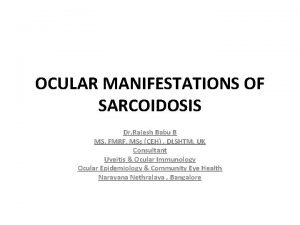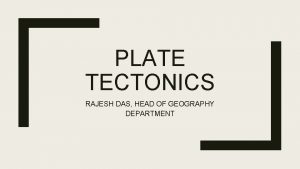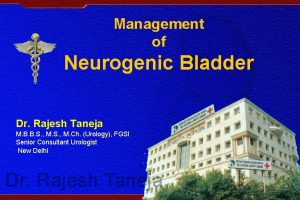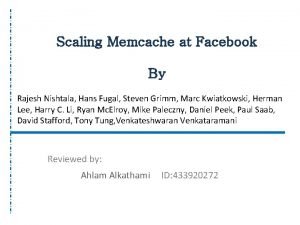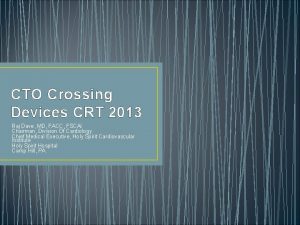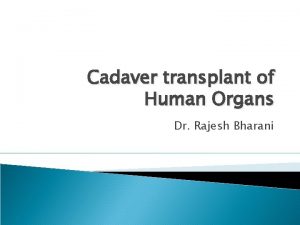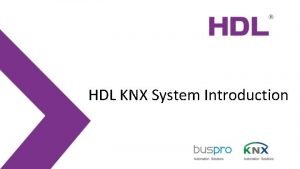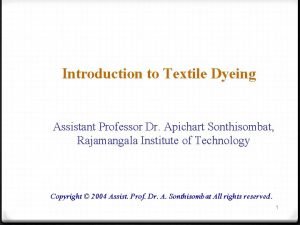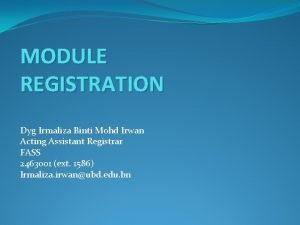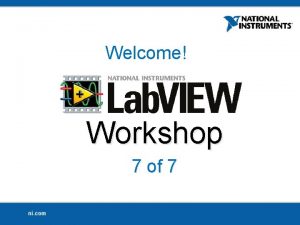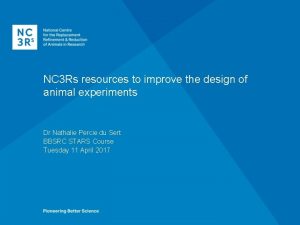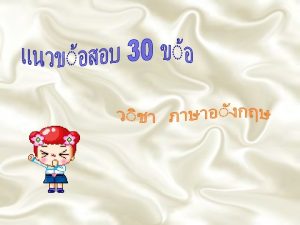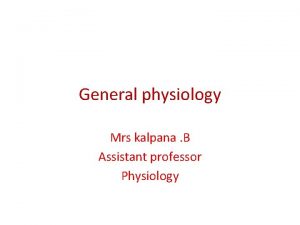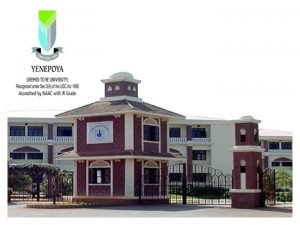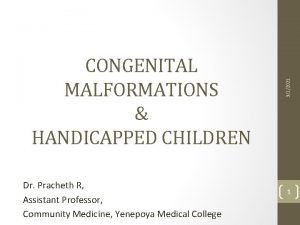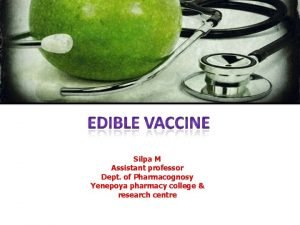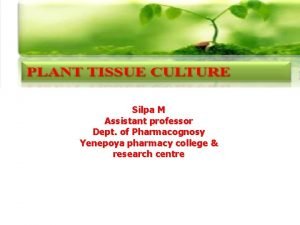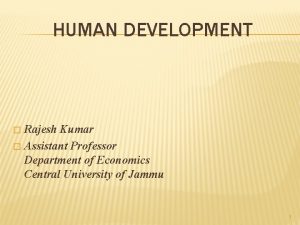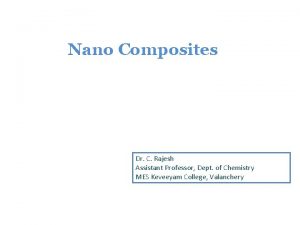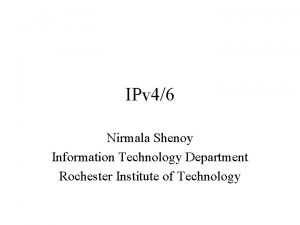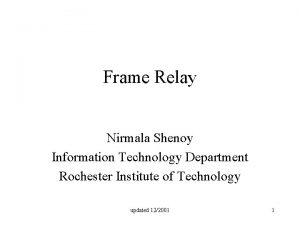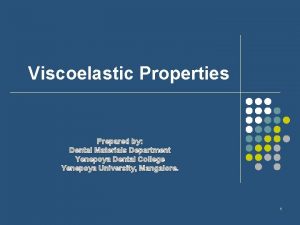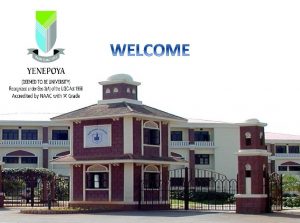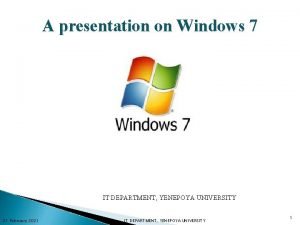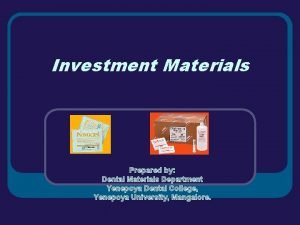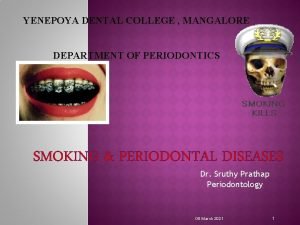Mrs Nirmala Rajesh Assistant Professor Physiology Department Yenepoya













































- Slides: 45

Mrs. Nirmala Rajesh Assistant Professor Physiology Department Yenepoya Medical College

THE NOMENCLATURE GREEK PHYSIO = NATURAL LOGOS = SCIENCE 3/7/2021 2

DEFINITION It is a branch of science, which tries to explain physical and chemical factors responsible for origin, development, and progression of life. OR A branch of science explaining normal life processes. 3/7/2021 3

HISTORY • Claude Bernard was a French physiologist and considered the “father” of modern experimental physiology. • His first works studied the physiology of digestion and the roles of the pancreas glands, gastric juices, and the intestines. He also studied the internal metabolism and understanding the glycogenesis in the liver. • He was also responsible of breakthroughs in understanding principles of organic life and homeostasis

ORGANISATION OF THE HUMAN BODY n n 3/7/2021 CELLS - 75 TRILLION. A Cooperative Society, organized as: TISSUES ORGANS SYSTEMS – General, Muscle & Nerve, Blood, Gastro-Intestinal, Cardiovascular, Respiratory, Nervous, Endocrines, Renal, Reproduction, Special senses, Temperature Regulation. 5

HOMEOSTASIS Homeo = Same, Stasis = Stability Definition: It is a comparative stability of the Internal environment. Coined by Walter B. Canon 3/7/2021 6

AIMS OF PHYSIOLOGY For an individual: Curiosity, Survival of self, Survival of species. ü For a Lab Scientist: Explaining mysteries of life by controlled Lab Experiments ü For a Physician: As a basis for understanding and treating diseases ü 3/7/2021 7

BLOOD Blood is fluid connective tissue in which cells are suspended in plasma

LEARNING OBJECTIVES: 1. Composition of blood 2. Function of blood 3. Serum

Composition of blood

Blood Solid cellular portion(45%) Liquid portion (55%) (formed elements) (clear yellow fluid) 91% water 9% solid Organic Inorganic 1% Na, K, Mg, Ca etc 7% plasma protein 1% other substance ● Albumin - Urea, creatine, uric acid, xanthine etc (NPN) ● Globulin -Amino acids, fatty acid, phospholipds etc ● Fibrinogen - hormones, Antibodies, Enzymes (Internal secretion)

• • Total blood volume : 5 -8 litres Specific gravity : 1050 – 1060 Viscosity : 4 -5 times of water p. H : 7. 4± 0. 05; alkaline Colour: opaque red Arterial blood is red Venous blood is dark red

Separated blood • Centrifuged blood – Plasma 55% – Buffy coat • WBCs <1% – Erythrocytes • Hematocrit 45%



Function of blood 1. 2. 3. 4. 5. 6. 7. 8. 9. 10. Transport of respiratory gases Transport of nutrition Excretory Storage Maintenance of water balance Regulation of body temperature Transport of hormones Defensive action Chemical homeostat coagulation

serum

PLASMA

LEARNING OBJECTIVES • To understand: • Plasma and its composition. • Plasma proteins – types, normal values and physical characteristics. • Functions of plasma proteins. • Sites of synthesis of plasma proteins • Edema and other applied aspects


• Plasma resembles interstitial fluid, but contains a unique mixture of proteins not found in other extracellular fluids • Differences between Plasma and IF 1. Levels of O 2 and CO 2 2. Dissolved proteins: – plasma proteins do not pass through capillary walls

Origin of Plasma Proteins • Embryo - mesenchymal cells through secretion of their substances. • In adults 1. Albumin & Fibrinogen – liver 2. Globulin from a. tissue macrophages. b. plasma cells c. lymphocytes – synthesize gamma globulins

Forms of plasma proteins • Normal total plasma protein concentration 6. 4 to 8. 3 gms. Per 100 ml of blood 3 Classes of Plasma Proteins Albumins (60%) 3 -5 gms%. Av. 4. 8 gms% Globulins (35%) 2 -3 gms% Av. 2. 3 gms% Fibrinogen (4%) 0. 3 gms% Prothrombin 40 mgms%

Plasma proteins • Albumin (mol. Weight 69000) – Helps control osmotic pressure – Helps control diffusion of water • Globulin (variable) – Includes antibodies (Abs) – Transport proteins (lipids, iron, copper, etc. ) • Fibrinogen (360000) – Involved in clotting


Pattern used for diagnostic purposes

Albumins Low molecular size, ellipsoid shape max. concentration • Produced in liver. Half life 19 days. • Concentration affected in liver disease • Transport substances: – fatty acids, drugs, bilirubin – thyroid hormones – steroid hormones •

Globulins • Elongated shape, formed in liver & RES. • Types alpha globulin( alpha 1&2) beta globulin ( beta 1&2) gamma globulin (gamma 1&2) • Varied functions

Globulins 1. Antibodies, also called immunoglobulins 1. Attack foreign bodies 2. Transport globulins (small molecules): – hormone-binding proteins – thyroid binding protein binds thyroid hormones;

– Metalloproteins- i. e. transferrin for Fe (alpha 2 globulin). Ceruloplasmin- Transport & storage of copper – apolipoproteins (lipoproteins) – Glycoprotein-carbohydrate + protein – steroid-binding proteins – i. e. testosterone binding hormone binds & transports testosterone – High concentration in plasma next to albumin.

Fibrinogen • Molecules form clots • Produce long, insoluble strands of fibrin • Deficiency causes defect in clotting mechanism


Other Plasma Proteins • • • Haptoglobins- Forms stable complex with Hb. Prothrombin- Role in clotting Angiotensinogen- Alpha 2 globulin Fetuin- Fetus & new borns- growth Complement system- Immunity Kinin system- Role in inflammation, clot lysis Fibrinolytic system- Clot lysis Coagulation factors- clotting Immuno globulins- Ig( gamma globulin) Haemagglutinins

Origin of Plasma protein ●Albumin and proteins concerned in blood clotting (Fibrinogen, prothrombin) are probably formed exclusively in the liver. ● Immunoglobulins are formed in lymphoid tissue by the plasma cells

A/G ratio • Albumin : Globulin : : 1. 7 : 1 • Reversed in liver disease &kidney disease where albumin decreased & globulin production remains almost normal.

Plasma proteins (7 g/100 ml). Formed chiefly in Liver ● ALBUMIN (4 g/100 ml) : Principle proteins responsible for exerting osmotic pressure of about 25 mm Hg across the capillary wall ---- Important in regulating interstitial fluid volume. Also performs transport function ● GLOBULIN (2. 7%g/100 ml) : Separated into c 1 α 2 β & γ. Vast majority of γ globulins are immunoglobulin α & β globulins act as carrier proteins --- eg Vitamins, hormones, drugs. ● FIBRINOGEN (0. 3 mg/100 ml) : Precursor of fibrin which forms frame work of blood clot.

Relation of diet to plasma proteins Whipple’s experiment : Studied in a standard plasma depleted dog Procedure : “ plasmapheresis” The rate of protein withdrawal exceeds the rate of regeneration. Result : Plasma proteins normally formed form food proteins.

Whipple suggested that proteins of cells are of 3 types. Fixed cell protein: Which is indispensable for cell life or activity Dispensable reserve proteins: Which can be called upon for energy & other purposes in starvations Labile reserve proteins: Readily turned out into blood stream to maintain the plasma – protein comcentration.

Functions of plasma proteins Role in coagulation of blood Transport function Maintenance of osmotic pressure Acid – base regulation Maintaining viscosity of blood Immune function Reservoir function

Applied physiology Hypoproteinaemia : Ø Cirrhosis of the liver Ø Nephrotic syndrome Ø Malnutrition Ø Starvation Ø Sprue Hyperproteinaemia Ø Multiple myeloma Ø kalazar Plasma protein Colloidal osmotic pressure oedema


2. Erythrocyte is another name for a: a) red cell b) white cell c) platelet 3. Which of the following blood components provide the major defense for our bodies against invading bacteria and viruses? a) red cells b) white cells c) platelets 4. The relatively clear liquid medium which carries the other cells of blood is called: a) lipid b) antibody c) plasma Most of the volume of normal human blood is composed of: a) red cells b) hemoglobin c) plasma d) white cells



 Kidney biopsy
Kidney biopsy Bitvci
Bitvci Www.yenepoya.edu.in yengage
Www.yenepoya.edu.in yengage Nirmala shenoy
Nirmala shenoy Yenepoya physiotherapy college
Yenepoya physiotherapy college Promotion from associate professor to professor
Promotion from associate professor to professor Cuhk salary scale 2020
Cuhk salary scale 2020 They are mrs garcia and mrs castro
They are mrs garcia and mrs castro Mrs. darling was ___________ of mrs. s.
Mrs. darling was ___________ of mrs. s. They are mrs garcia and mrs castro
They are mrs garcia and mrs castro Tcs
Tcs Rajesh prasad ias assam
Rajesh prasad ias assam Rajesh kadakia
Rajesh kadakia Bmi 26 female
Bmi 26 female Rajesh kumar bhagat
Rajesh kumar bhagat Dr rajesh batajoo
Dr rajesh batajoo Simcafe cornell
Simcafe cornell Rajesh creates a logic circuit
Rajesh creates a logic circuit Rajesh shah thoracic surgeon
Rajesh shah thoracic surgeon Silverlight seminar ppt download
Silverlight seminar ppt download Dr rajesh garg
Dr rajesh garg Dr rajesh babu
Dr rajesh babu Rajesh das
Rajesh das Transportation engineering
Transportation engineering Rajesh shewani
Rajesh shewani Naga rajesh tummala
Naga rajesh tummala Probanthin adalah
Probanthin adalah Memory management
Memory management Facebook scaling memcache
Facebook scaling memcache About the bed
About the bed Rajesh dave md
Rajesh dave md Dr rajesh bharani
Dr rajesh bharani Assistant techer
Assistant techer Hdl knx
Hdl knx Mrs rajlaxmi is working
Mrs rajlaxmi is working Printing and dyeing assistant
Printing and dyeing assistant Ibm support assistant
Ibm support assistant Assistant registrar ubd
Assistant registrar ubd Daq swim
Daq swim Cisco personal communications assistant
Cisco personal communications assistant Efda definition
Efda definition Siri dahl personal assistant
Siri dahl personal assistant Experimental design assistant
Experimental design assistant Matrox iris gt
Matrox iris gt Shop assistant good evening what can i do for you
Shop assistant good evening what can i do for you Sql server migration assistant for sybase
Sql server migration assistant for sybase
